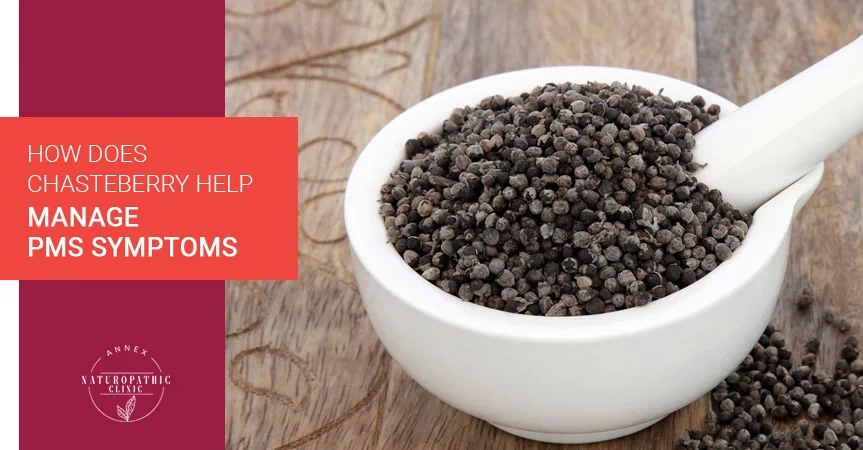Improve your health naturally, with the help of experienced naturopathic doctors Book An Appointment
What Is PMS?
PMS, or premenstrual syndrome, refers to a collection of symptoms that tend to ebb and flow along with your monthly cycle. Women and others who menstruate can face a wide variety of different symptoms. These symptoms can be broken into two categories: physical and psychological. Physical symptoms of PMS can include:- Headaches
- Digestive issues
- Breast soreness
- Digestive issues
- Bloating
- Mood swings
- Irritability
- Anxiety
- Confusion
- Depression
- Insomnia
PMS-A
PMS-A mostly manifests in anxiety, including symptoms like:- Feeling overwhelmed
- More sensitive than usual
- Irritability
PMS-C
PMS-C is associated with cravings, in particular junk food cravings. With PMS-C, you may experience:- Carbohydrate cravings
- General higher appetite
- Fatigue
- Headaches
PMS-D
PMS-D is most associated with depression. Common symptoms include:- Depression
- Lethargy
- Forgetfulness
- Confusion
PMS-H
PMS-H is most closely related to water retention – the H stands for hydration. Common symptoms include:- Bloating in the abdomen
- Breast tenderness
- Temporary weight gain (more than 3 pounds)
Improve your health naturally, with the help of experienced naturopathic doctors Book An Appointment
What Is Chasteberry?
Chasteberry is an herb native to the Mediterranean region of Southern Europe, North Africa, and Western Asia. It’s known by many different names, including vitex, vitex agnus-castus (its scientific name), chaste tree, Abraham’s balm, lilac chastetree, and monk’s pepper. Let’s keep it simple though. Chasteberry has two primary compounds that make it useful from a medicinal perspective.Flavonoids In Chasteberry
Flavonoids are substances you can find in a wide variety of different plant-based foods and substances. In particular, the flavonoids in chasteberry include:- Casticin
- Isovitexin
- Quercetagetin
- Kaempferol
- Orientin
Essential Oils In Chasteberry
The essential oils in chasteberry give it its smell and its flavour. The individual elements in the chasteberry’s essential oils include:- Cineol
- Limonene
- Pinene
- Sabinene
Using Chasteberry To Manage PMS
Traditionally, chasteberry was used as both an aphrodisiac and a galactagogue – a substance that increases breast milk. However, there is no scientific evidence for these. There is, however, evidence that chasteberry can help manage PMS symptoms. Let’s take a look.1. It Can Help Manage Breast Tenderness
Breast tenderness is a common symptom of PMS. The scientific term for it is “mastalgia,” and it can have many different causes. Though folks often default to fearing breast cancer and seeking, naturopathic breast cancer adjunctive treatment, mastalgia is related to breast cancer in fewer than 1% of cases. A 2007 study by A.R. Carmichael took a look at the evidence for using chasteberry to manage mastalgia, regardless of its cause. Exploring a variety of data from a variety of studies, they concluded that chasteberry can be quite effective in the treatment of mastalgia.2. It Can Help Manage Anxiety
As we explored above, anxiety is a common symptom of PMS-A. Chasteberry can help. A 2019 study by Naseri et al worked with a study group of 52 women who complained of various PMS symptoms, including anxiety. Dividing them into two groups – a chasteberry group and a placebo group – they found the group taking chasteberry had significantly improved experience of anxiety, as well as other symptoms.3. It Can Help Manage PMS Induced Migraines
If you suffer from migraines, you know how difficult they can be. Headaches are a typical symptom of PMS-C, but if you also suffer from migraines it can trigger those instead. A 2012 study by Ambrosini et al studied 100 women who’d taken chasteberry for migraines related to PMS, and 92% of them reported either a dramatic or a mild reduction in PMS symptoms. What’s more, 42% reported more than 50% fewer headaches, and 57% reported 50% fewer days with headaches.4. It Can Help Manage PMDD Induced Depression
PMDD stands for premenstrual dysphoric disorder. It’s a more extreme version of PMS that can include serious emotional changes, including severe depression. However, chasteberry can help with that too. A 2003 study by Atmaca, Kumru, and Tezcan compared the use of fluoxetine (Prozac) and chasteberry as treatment for depression associated with PMDD. It found that fluoxetine and chasteberry had a similar rate of effectiveness at addressing pmdd symptoms, including depression. More research is needed on the effects of chasteberry for PMDD, but this is a promising first step.Are There Risks With Taking Chasteberry?
In general, chasteberry is considered well tolerated. Side effects tend to be rare and mild, but may include:- Nausea
- Headache
- Digestive discomfort
- Itching
Book An Appointment With Annex Naturopathic
Curious about chasteberry? Do you struggle with PMS symptoms and are hoping to find relief? If so, book an appointment with Annex Naturopathic today. One of our experienced and knowledgeable naturopathic doctors will listen to your concerns and put together a plan to help manage your PMS symptoms.

